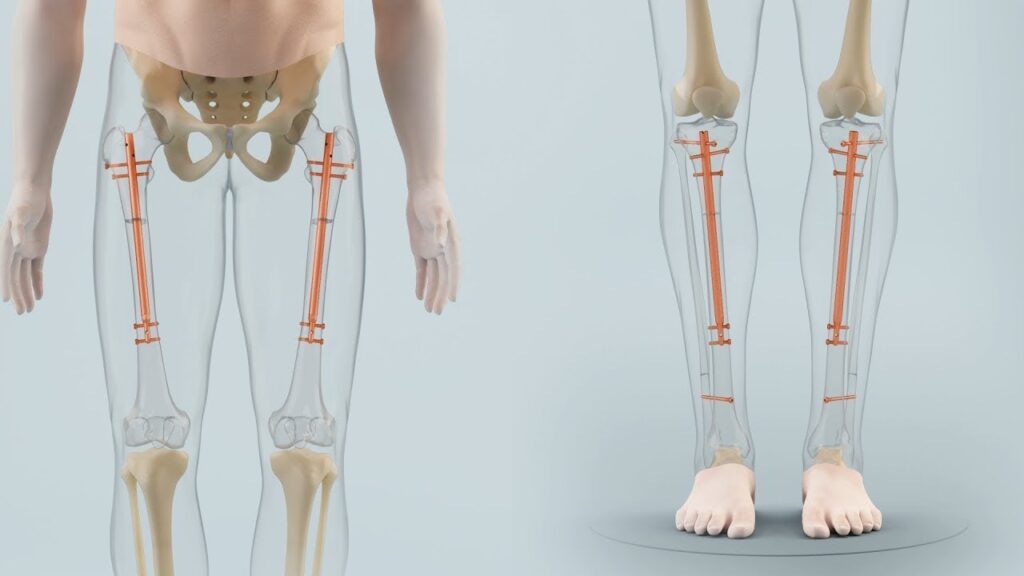Discover how limb lengthening surgery works, including the procedures, recovery process, benefits, and potential risks involved in this transformative orthopedic surgery.

Outline
| Headings | Sub-Headings |
|---|---|
| Introduction | – Understanding Limb Lengthening Surgery |
| The Basics of Limb Lengthening Surgery | – What is Limb Lengthening Surgery? |
| – Who Can Benefit from Limb Lengthening Surgery? | |
| Historical Background | – Early Techniques |
| – Evolution of Modern Methods | |
| Pre-Surgery Evaluation and Preparation | – Medical Assessment |
| – Psychological Preparation | |
| – Pre-Surgery Physical Therapy | |
| Types of Limb Lengthening Surgery | – External Fixation Devices |
| – Internal Lengthening Devices | |
| – Combined Techniques | |
| The Limb Lengthening Procedure | – Initial Surgery |
| – Gradual Distraction Phase | |
| – Consolidation Phase | |
| Technology in Limb Lengthening Surgery | – Role of External Fixators |
| – Innovations in Internal Devices | |
| – Use of Advanced Imaging Techniques | |
| Recovery Process and Rehabilitation | – Post-Surgery Care |
| – Physical Therapy | |
| – Monitoring and Follow-Up | |
| Common Risks and Complications | – Potential Surgical Risks |
| – Long-Term Complications | |
| Success Rates and Outcomes | – Factors Influencing Success |
| – Patient Testimonials | |
| Applications of Limb Lengthening Surgery | – Treating Congenital Deformities |
| – Addressing Trauma-Induced Limb Shortening | |
| – Cosmetic Enhancements | |
| Ethical Considerations | – Informed Consent |
| – Psychological Implications | |
| Future Directions in Limb Lengthening Surgery | – Emerging Technologies |
| – Research and Development | |
| FAQs | – |
| – What is limb lengthening surgery? | |
| – How is the surgery performed? | |
| – What are the risks associated with limb lengthening surgery? | |
| – How long does recovery take? | |
| – Who is a candidate for limb lengthening surgery? | |
| – What advancements are expected in the future? | |
| Conclusion | – |
How Limb Lengthening Surgery Works: A Comprehensive Guide
Limb lengthening surgery is a transformative procedure that has evolved significantly over the years. It offers hope and improved quality of life for individuals with limb discrepancies and deformities. This article explores how limb lengthening surgery works, from the initial assessment to the recovery process, highlighting key aspects of this intricate procedure.
Introduction
Limb lengthening surgery, a highly specialized orthopedic procedure, involves the gradual stretching of bones to increase their length. This surgery is used to correct congenital deformities, address trauma-induced limb shortening, and for cosmetic enhancements. Understanding the process, benefits, and risks involved can help prospective patients make informed decisions.
The Basics of Limb Lengthening Surgery
What is Limb Lengthening Surgery?
Limb lengthening surgery is a medical procedure designed to increase the length of bones in the legs or arms. This is achieved through a controlled surgical technique known as distraction osteogenesis, where the bone is cut and gradually separated to allow new bone tissue to form in the gap.
Who Can Benefit from Limb Lengthening Surgery?
Individuals with congenital limb length discrepancies, those recovering from traumatic injuries that resulted in limb shortening, and patients seeking cosmetic improvements can benefit from this surgery. Proper medical evaluation is essential to determine candidacy.
Historical Background
Early Techniques
The origins of limb lengthening can be traced back to ancient attempts using rudimentary methods like traction and splints. These early techniques were often fraught with complications and limited success.
Evolution of Modern Methods
Significant advancements were made in the 20th century, particularly with the introduction of the Ilizarov method by Dr. Gavriil Ilizarov. This technique revolutionized the field, providing a more controlled and effective way to lengthen bones.
Pre-Surgery Evaluation and Preparation
Medical Assessment
Before undergoing limb lengthening surgery, patients must undergo a thorough medical assessment. This includes evaluating bone health, overall physical health, and any underlying conditions that might affect the surgery or recovery process.
Psychological Preparation
Psychological readiness is crucial for successful outcomes. Patients should undergo psychological evaluation and counseling to ensure they are mentally prepared for the demands and challenges of the surgery and recovery period.
Pre-Surgery Physical Therapy
Physical therapy before surgery can help prepare the muscles and joints for the procedure. Strengthening and conditioning exercises improve the patient’s readiness and can lead to better post-surgery outcomes.
Types of Limb Lengthening Surgery
External Fixation Devices
External fixation devices, such as the Ilizarov apparatus, involve attaching a frame to the outside of the limb with pins and wires. These devices allow for precise control over the bone lengthening process.
Internal Lengthening Devices
Internal lengthening devices, like intramedullary nails, are inserted inside the bone. These devices reduce the need for external hardware and are less visible, offering a more comfortable option for patients.
Combined Techniques
In some cases, a combination of external and internal devices may be used. This approach can provide the benefits of both methods, optimizing the lengthening process and improving outcomes.
The Limb Lengthening Procedure
Initial Surgery
The limb lengthening process begins with an initial surgery, where the bone is cut (osteotomy) to create a controlled fracture. Devices for gradual distraction are then installed.
Gradual Distraction Phase
During the distraction phase, the bone segments are gradually pulled apart. This is typically done at a rate of about 1 millimeter per day, allowing new bone tissue to form in the gap.
Consolidation Phase
After the desired length is achieved, the consolidation phase begins. During this time, the new bone tissue hardens and becomes strong enough to support normal activities. This phase can take several months.
Technology in Limb Lengthening Surgery
Role of External Fixators
External fixators play a critical role in controlling the bone lengthening process. These devices allow for precise adjustments and monitoring throughout the distraction phase.
Innovations in Internal Devices
Recent advancements in internal devices, such as motorized intramedullary nails, have improved the comfort and convenience of limb lengthening surgery. These devices can be adjusted without invasive procedures, enhancing patient experience.
Use of Advanced Imaging Techniques
Advanced imaging techniques, including X-rays and CT scans, are used to monitor the progress of bone lengthening and ensure proper alignment. These technologies help in making accurate adjustments and avoiding complications.
Recovery Process and Rehabilitation
Post-Surgery Care
Post-surgery care involves managing pain, preventing infection, and monitoring the healing process. Patients are often prescribed medications and are closely monitored by their healthcare team.
Physical Therapy
Physical therapy is essential during the recovery process. It helps maintain joint mobility, muscle strength, and overall function. Regular therapy sessions are crucial for a successful recovery.
Monitoring and Follow-Up
Regular follow-up appointments are necessary to monitor the progress of bone lengthening and address any complications. Imaging studies are used to assess bone healing and ensure proper alignment.
Common Risks and Complications
Potential Surgical Risks
Risks associated with limb lengthening surgery include infection, nerve damage, and blood clots. Surgeons take preventive measures to minimize these risks, but patients must be aware of potential complications.
Long-Term Complications
Long-term complications can include joint stiffness, muscle contractures, and unequal bone growth. Ongoing monitoring and rehabilitation are essential to manage and mitigate these issues.
Success Rates and Outcomes
Factors Influencing Success
The success of limb lengthening surgery depends on various factors, including patient health, adherence to post-surgery care, and the expertise of the surgical team. Successful outcomes are characterized by proper bone healing and improved function.
Patient Testimonials
Many patients report significant improvements in their quality of life following limb lengthening surgery. Testimonials highlight increased mobility, reduced pain, and enhanced self-esteem as common benefits.
Applications of Limb Lengthening Surgery
Treating Congenital Deformities
Limb lengthening surgery is frequently used to correct congenital deformities such as leg length discrepancies and skeletal dysplasia. These procedures can significantly improve patient mobility and function.
Addressing Trauma-Induced Limb Shortening
Patients who have experienced severe trauma resulting in limb shortening can benefit from limb lengthening surgery. Restoring limb length helps improve balance, gait, and overall functionality.
Cosmetic Enhancements
Cosmetic limb lengthening is an option for individuals seeking to increase their height. While this application is more controversial, it offers psychological and aesthetic benefits for some patients.
Ethical Considerations
Informed Consent
Informed consent is a critical aspect of limb lengthening surgery. Patients must fully understand the risks, benefits, and potential outcomes before undergoing the procedure.
Psychological Implications
The psychological implications of limb lengthening surgery are significant. Patients should receive thorough counseling to ensure they are prepared for the emotional and mental challenges of the process.
Future Directions in Limb Lengthening Surgery
Emerging Technologies
Emerging technologies, such as robotics and 3D printing, are poised to further advance limb lengthening surgery. These innovations aim to enhance precision, reduce recovery times, and improve overall outcomes.
Research and Development
Ongoing research and development in the field of limb lengthening surgery continue to explore new techniques and devices. These efforts aim to improve patient safety, comfort, and success rates.
FAQs
What is limb lengthening surgery?
Limb lengthening surgery is a procedure to increase the length of bones in the legs or arms using controlled surgical techniques like distraction osteogenesis.
How is the surgery performed?
The surgery involves cutting the bone (osteotomy), installing devices for gradual distraction, and slowly separating the bone segments to allow new bone tissue to form.
What are the risks associated with limb lengthening surgery?
Risks include infection, nerve damage, joint stiffness, and long-term complications like unequal bone growth and muscle contractures.
How long does recovery take?
Recovery can take several months to a year, depending on the length of bone being lengthened and the patient’s overall health. The process includes a distraction phase and a consolidation phase.
Who is a candidate for limb lengthening surgery?
Candidates include individuals with congenital limb discrepancies, trauma-induced limb shortening, or those seeking cosmetic height enhancement. Proper medical and psychological evaluations are essential.
What advancements are expected in the future?
Future advancements may include the use of robotics, 3D printing, and regenerative medicine techniques. These innovations aim to improve precision, reduce recovery times, and enhance patient outcomes.
Conclusion
Limb lengthening surgery is a complex and transformative procedure that offers significant benefits for individuals with limb discrepancies and deformities. Understanding how the surgery works, the recovery process, and potential risks can help patients make informed decisions and achieve successful outcomes.



